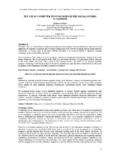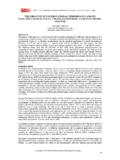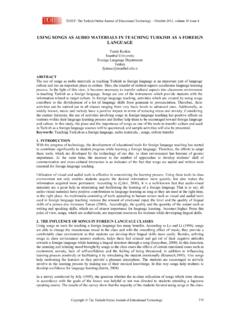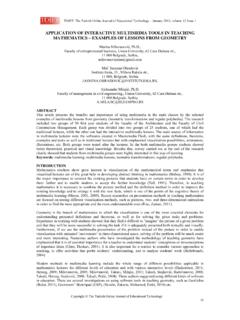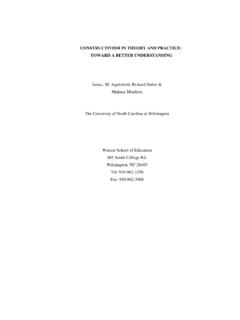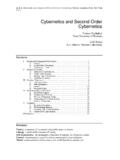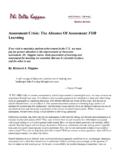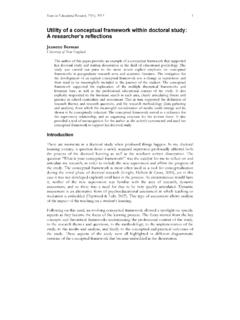Transcription of THE USE OF COMPUTERS IN MATHEMATICS …
1 The Turkish Online Journal of Educational Technology TOJET April 2005 ISSN: 1303-6521 volume 4 Issue 2 Article 4. THE USE OF COMPUTERS IN MATHEMATICS education : A PARADIGM. SHIFT FROM computer ASSISTED INSTRUCTION TOWARDS STUDENT. PROGRAMMING . Dr. Emin Ayd n - ABSTRACT. The purpose of this study is to review the changes that COMPUTERS have on MATHEMATICS itself and on MATHEMATICS curriculum. The study aims at investigating different applications of COMPUTERS in education in general, and MATHEMATICS education in particular and their applications on MATHEMATICS curriculum and on teaching and learning of MATHEMATICS . There are three broad categories of the applications of COMPUTERS in the field of MATHEMATICS education : computer assisted instruction (CAI), student (educational) programming and general purpose educational tools such as spreadsheets, databases and computer algebra systems (CAS).
2 This study presents a historical background and attempts to describe the paradigmatic shift in the use of COMPUTERS in MATHEMATICS education from behavioristicly oriented CAI movement towards constructivist based student programming movement. INTRODUCTION. The educational history of COMPUTERS began in sixties with the realization of its potential to teaching and learning. That was a period of enchantment. According to Suppes et al. (1968) the change that was to come through COMPUTERS could only be compared to the fact that how books had changed the way of people looking at the world. COMPUTERS would change the face of education in a very short period of time by eventually removing the teacher from the classroom scene. Looking in retrospect, can it really be said that his predictions were realized? Or is it just a techno-romantism (Underwood and Underwood, 1990) to believe that the computer is a panecea for all of the problems in education .
3 Allthough not having been able to solve all of the problems of education by itself, this powerful machine, no doubt, will continue to occupy a very central place in education . A major figure in the history of COMPUTERS , besides Suppes, in education is Seymour Papert who is famous for his work Mindstorms (1980) which presents quite revolutionary ideas about the place of the COMPUTERS in education . He, like Suppes argued that the computer would change the face of education , but unlike Suppes he advocated the use of the computer not as a teaching machine but as a device to develop learners' intellectual skills through writing their own programs to direct the computer and not let the computer direct themselves. It seems that the effect of computer technology on education is greater in MATHEMATICS than in any other discipline.
4 This may be because of the close links between the two disciplines. In fact the computer science was a part of MATHEMATICS and afterwards gained independence as a sole discipline. The purpose of this study is to review the changes that COMPUTERS have on MATHEMATICS itself and on MATHEMATICS curriculum. The study aims at investigating the following questions: 1. What are different applications of COMPUTERS in education in general, and MATHEMATICS education in particular? 2. What are the effects of these applications on MATHEMATICS curriculum and on teaching and learning of MATHEMATICS ? COMPUTERS IN MATHEMATICS education . MATHEMATICS instruction is among the most explored research area in education . There have been considerably varied computer applications in instruction (Hatfield, 1984). The teachers of MATHEMATICS are confused with the extensive amount of suggestions on how to teach MATHEMATICS with a computer .
5 Teachers' attitudes towards COMPUTERS vary mostly as a function of teachers' age or years in service. Complete ignorance' attitude towards COMPUTERS still continues, although its magnitude is weaker compared to past years This attitude is mostly shared by teachers who had had their training before the start of the computer age who have the most negative attitudes towards its pedagogical use and who insist on using the traditional modes of teaching. Second major attitude is not being able to abandon their traditional habits completely foreseeing its potential for the future of education . Most prevalent and widening attitude is the realisiation and acceptance of the importance of COMPUTERS for education . 27. The Turkish Online Journal of Educational Technology TOJET April 2005 ISSN: 1303-6521 volume 4 Issue 2 Article 4.
6 There are three broad categories of the applications of COMPUTERS in the field of MATHEMATICS education : computer assisted instruction (CAI). student (educational) programming general purpose educational tools such as spreadsheets, databases and computer algebra systems (CAS). This survey of literature revealed that, this categorization is also a historical one, although it cannot be said that there were sharp shifts from one movement to another. Another important note is that the CAI movement is not as popular in the Europe as it is in United States. 1. computer assisted instruction (CAI) and its effects on MATHEMATICS curriculum Behavior modification programs before CAI. There are two major events that had a great influence on education in general and MATHEMATICS education in particular in 1958 (Dick, 1986). The first one is the Sputnik event, the satellite launched by the Russians.
7 The other one is the paper presented by Skinner, an influential and famous neo-behaviorist, on programmed instruction. Behaviorism is considered to be the theory underlying CAI. Hence, it is understandable that the CAI programs are mainly behavioral control programs (Hartley, 1981). An example is Skinner's Programmed Instruction (PI). which was designed to change the behavior of the learners. Fundamental approach of Skinner was to identify the desired behaviors, then to prepare situations in which successive approximations of the behavior would be reinforced. All the students study the so called linear text", the instructional material used by Skinner. When students complete the text, they were assumed to have acquired the behaviors required from them. The basic characteristic of programmed instruction is the small steps approach, meaning the division of the task into small manageable units, and the immediate feedback given to students from each response they give.
8 The teaching machine is the box designed to expose the programmed instruction text one frame at a time. It is commonly considered to be ancestor of the device called the computer " to be used for educational purposes. Skinner's programmed instruction formed a basis for the computer assisted instruction movement (Dick, 1986). Among several other trends Skinner's PI became more widespread than the others. Other major movements in that tradition which followed PI chronologically were Glaser's individually prescribed instruction (IPI) and Keller's personalized system of instruction (PSI). Both approaches contributed to the individualization of instruction movement in similar ways. In Keller's (1968) PSI there were self-paced courses in which students were required to master successive unit tests. Bloom's (1976) is considered to be the last widespread individualized approach to instruction, before computer assisted instruction movement.
9 The method involve the mastery of certain subject area ( trigonometry) before passing to another. According to Hilgard (1986) these approaches to instruction had important consequences for educational psychology. the individualized instruction based on the idea that best learning outcomes can only be obtained with one to one tutoring approach. The claim related to those behaviorist models of instruction was that they could provide learning environments closer to one-to-one tutoring (Bloom, 1976). the diagnostic teaching which is based on the immediate feedback obtained from the responses of students to the questions being asked during the instructional process. the step-by-step approach they presented in the instruction of a certain learning task. Those programs advance in a way such that one sub-task followed the other, in other words one frame at a time as in teaching machines.
10 Therefore, in each step, what is expected from the user should be specified in terms of observable behaviors. According to Mager (1962) a behavioral objective has four basic components. The first component is the actor or the learner who is supposed to act in the prescribed manner. Second component is the behavior itself. The condition(s) under which that action would occur and the criteria to judge if the behavior is applicable are the third and fourth components respectively. The types of CAI programs CAI means, in broader terms, the use of a computer to provide the course content in the form of drill, practice, tutorial, and simulations. Demonstration, testing, information, and communication are the main facilities provided by CAI. Hatfield (1985) counts eight basic types of CAI. The first type of CAI includes drill and 28.
